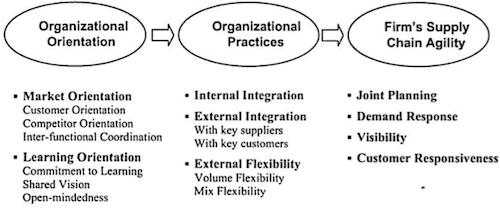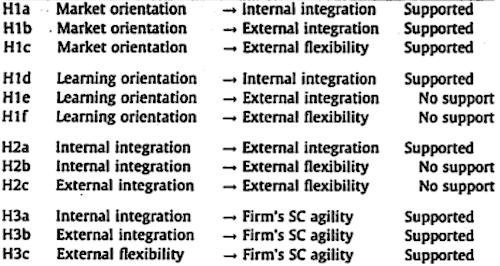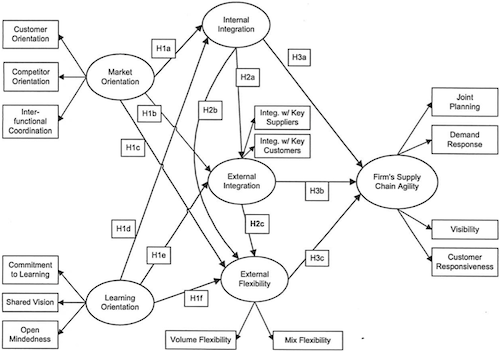The organizational Antecedents of a Firm's Supply Chain Agility
This time I’d like to have a look at supply chain risk management from a strategic point of view: What are the prerequisites in the design and culture of an organization to mitigate supply chain risks? The title of the article I review today is: “The organizational antecedents of a firm’s supply chain agility for risk mitigation and response”.
Method
The authors use structural equation modeling technique to establish the relations within their model (figure 1).

The model proposes a linkage between the organizational orientation of a company related to the market and continuous learning. Those design factors should lead towards internal and external integration of the company and its supply chain as well as external flexibility as practices within the organization. This in turn should lead to agility, which is defined as
the capability of the firm, internally, and in conjunction with its key suppliers and customers, to adapt or respond in a speedy manner to a changing marketplace, contributing to agility of the extended supply chain.
Agility is measured by the proxies: joint planning, demand response, increased visibility and customer responsiveness.
The authors augment their model by several proposed relationships / hypothesis shown in figure 2.
As the method of choice to validate or reject the established hypothesis a survey was created and validated by a panel of ten experts from research and business. Of a sample size (email addresses) of 2955, 218 usable responses were received.
Results
The final results for each hypothesis is shown in figure 3. The hypothesis regarding the relationship between learning orientation and internal and external orientation were not supported as were the hypothesis on the relationship between internal and external integration and internal and external flexibility.

Nonetheless the authors can conclude:
All three organizational practices of internal integra tion, external integration and adoption of external flexible practices were found to be direct antecedents of a firm’s supply chain agility, explaining a significant portion of the variance in the FSCA construct. Among these three antecedents, external integration with key suppliers and customers was seen to be the strongest predictor of a firm’s supply chain agility.
Also the cultural antecedents are shown to have an impact on the organizational practices.
Of the cultural drivers, market orientation was seen to directly affect both types of integration. […] Learning orientation was shown to have a strong and significant influence on internal integration.
Conclusion
I think the article highlights several important aspects. Coming from the supply chain strategy it summarized different organizational practices / tactics which have to be implemented to create a agile company in the supply chain context. The authors do a good job in operationalizing these different states / activities and therefore define quite precisely what they mean by the cultural antecedents, practices and agility.
On the other hand after reading the title (”… agility for risk mitigation and response”) I was expecting some more research on the connection between a companies agility and the reduction of risk, but it seems that the impact of the firm’s supply chain agility was not part of the main survey but “only” elaborated in the literature review.
Braunscheidel, M., & Suresh, N. (2009). The organizational antecedents of a firm’s supply chain agility for risk mitigation and response Journal of Operations Management, 27 (2), 119-140 DOI: 10.1016/j.jom.2008.09.006









Add new comment